Three years ago, I watched a line chef at a bustling Tokyo ramen shop meticulously tend to a pot that had been simmering for eighteen hours straight. The broth was liquid gold rich, complex, and deeply satisfying. That moment sparked an obsession that led me down a rabbit hole of ramen science, ultimately discovering how a slow cooker could replicate those same profound flavors at home.
Slow cooker beef ramen isn’t just another weeknight dinner shortcut. It’s a masterclass in patience and technique, where time becomes your most valuable ingredient. This dish bridges the gap between authentic Japanese ramen craftsmanship and modern convenience cooking, creating a bowl that rivals anything you’d find in a proper ramen-ya.
The magic happens in the extended cooking process, where tough cuts of beef break down into silky, fork-tender morsels while simultaneously building a broth so rich it coats the back of a spoon. What sets this recipe apart is the layered approach to flavor building each ingredient added at precisely the right moment to maximize its contribution to the final dish.
Understanding the Foundation: Ingredients & Substitutions
The Beef Component
Chuck roast stands as the undisputed champion for slow cooker ramen. This well-marbled cut contains enough connective tissue to create natural gelatin during the long cooking process, giving your broth that coveted body and mouthfeel. A 3-4 pound roast feeds six people generously, with leftovers that actually improve overnight.
Short ribs offer an equally compelling alternative, particularly if you prefer a more intense beef flavor. The bone-in variety adds extra collagen to the broth, though boneless works perfectly fine. Brisket makes another excellent choice, especially the point cut with its higher fat content.
Avoid lean cuts like sirloin or round roasts they’ll dry out and contribute little to the broth’s development. The fat and connective tissue aren’t obstacles to overcome; they’re essential building blocks for creating restaurant-quality results.
Aromatics That Build Complexity
Yellow onions form the backbone of our flavor base. Two large onions, roughly chopped, provide sweetness that balances the beef’s richness. White onions work in a pinch, but their sharper bite can overpower the delicate balance we’re seeking.
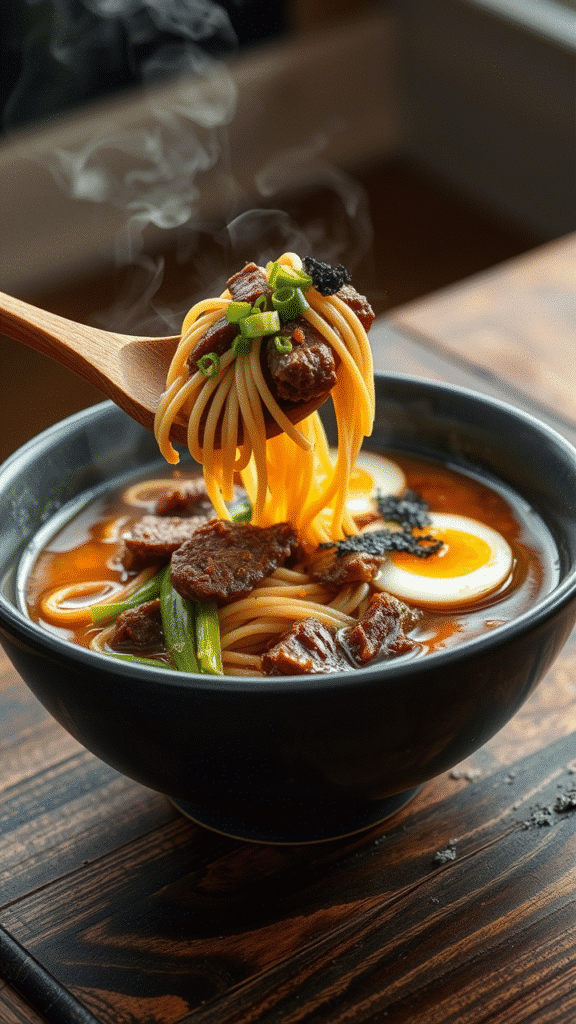
Fresh ginger and I mean fresh, not powdered brings warmth and subtle heat that complements beef beautifully. A 3-inch piece, sliced thin, releases its oils slowly during the cooking process. Galangal substitutes wonderfully if you can source it, adding a more floral, citrusy note.
Garlic needs no introduction, but the amount matters. Eight cloves might seem excessive, but remember—this recipe feeds six people and cooks for eight hours. The long cooking time mellows garlic’s bite while concentrating its savory essence.
The Umami Arsenal
Soy sauce provides the salty backbone, but not all soy sauces are created equal. Japanese shoyu brings a cleaner, more refined flavor than Chinese varieties. Tamari works excellently for gluten-free needs, though it’s slightly more intense, so reduce the quantity by about 25%.
Miso paste transforms this from good to transcendent. White miso offers mild sweetness and subtle funk, while red miso brings deeper, more assertive flavors. A combination of both creates incredible depth use 2 tablespoons white and 1 tablespoon red for perfect balance.
Worcestershire sauce might seem out of place in a Japanese-inspired dish, but its complex blend of anchovies, molasses, and spices adds layers that pure Japanese ingredients can’t match. Fish sauce provides another umami boost, though use it sparingly a little goes a long way.
Vegetables for Color and Nutrition
Carrots add natural sweetness and beautiful color. Cut them into thick rounds so they don’t completely dissolve during the long cooking time. Baby carrots work fine but lack the concentrated flavor of full-sized varieties.
Bok choy brings freshness and textural contrast to the rich broth. Add it during the last 30 minutes of cooking to preserve its vibrant green color and slight crunch. Napa cabbage substitutes well, as does regular cabbage in smaller quantities.
Mushrooms contribute additional umami depth. Shiitake mushrooms are traditional and offer the most authentic flavor, but cremini or even button mushrooms work perfectly. Dried shiitakes can be rehydrated and used alongside fresh varieties for even more intensity.
Noodle Selection and Preparation
Fresh ramen noodles are ideal, but dried varieties work perfectly well. Look for packages labeled “chukamen” or “ramen” specifically regular spaghetti or lo mein noodles won’t provide the proper texture or flavor absorption.
Cook noodles separately from the slow cooker to prevent overcooking and mushiness. The starch released during noodle cooking can also cloud your carefully crafted broth. Prepare them al dente they’ll finish cooking when combined with the hot broth.
Step-by-Step Mastery: Building Layers of Flavor
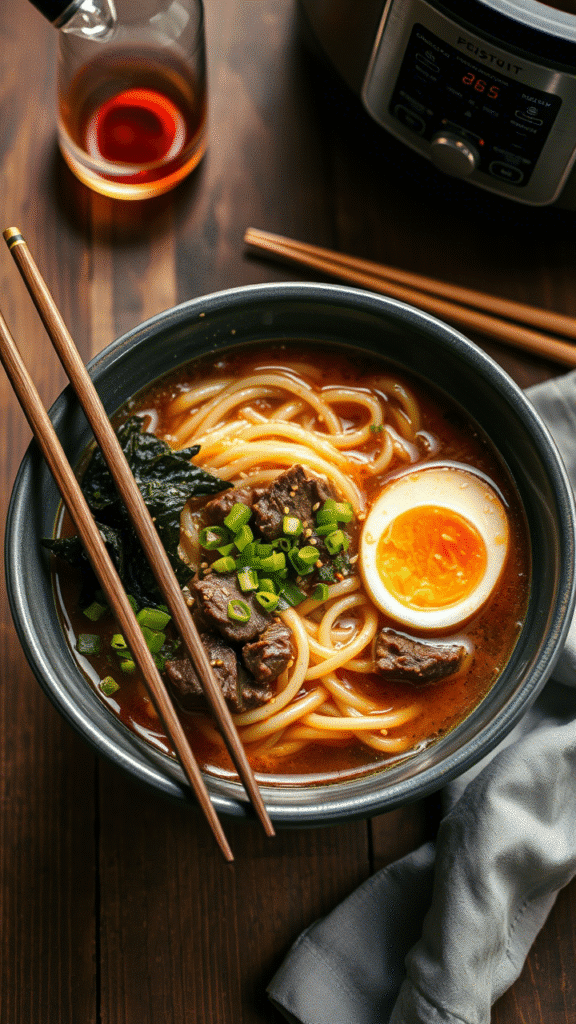
Initial Preparation and Searing
Start by patting your beef completely dry with paper towels. Moisture prevents proper browning, which means lost flavor opportunities. Season generously with salt and black pepper at least 30 minutes before cooking this allows the seasoning to penetrate the meat’s surface.
Heat a large skillet over medium-high heat. Add a thin film of neutral oil vegetable or canola work perfectly. Sear the beef on all sides until deep golden brown develops, approximately 4-5 minutes per side. This Maillard reaction creates hundreds of flavor compounds that slow cooking alone cannot achieve.
Don’t rush this step. Proper searing takes patience, and moving the meat too early prevents browning. The beef should release easily from the pan when properly seared if it sticks, it needs more time.
Building the Aromatic Base
After removing the beef, use the same pan to sauté your aromatics. The fond left from searing contains concentrated flavor that would be criminal to waste. Add onions first, cooking until they develop light caramelization around the edges, about 5-6 minutes.
Ginger and garlic come next, cooking just until fragrant maybe 60 seconds. Overcooked garlic turns bitter and ruins everything you’ve built so far. The goal is to awaken their oils without destroying their delicate flavors.
Deglaze the pan with a splash of beef broth or cooking wine, scraping up every precious bit of fond. This liquid gold goes straight into your slow cooker, carrying with it layers of concentrated flavor.
The Long, Slow Dance
Transfer the seared beef to your slow cooker, followed by the sautéed aromatics and deglazing liquid. Add enough beef broth to cover the meat by about 2 inches usually 6-8 cups depending on your slow cooker’s size and the beef’s dimensions.
Stir in soy sauce, miso paste (whisk it with a bit of warm broth first to prevent lumps), Worcestershire sauce, and fish sauce. The miso can be stubborn about dissolving, so take time to whisk it thoroughly before adding to the pot.
Set your slow cooker to low and walk away for 6-8 hours. Resist the urge to lift the lid frequently each peek releases valuable heat and extends cooking time. Trust the process and let time work its magic.
Final Assembly and Timing
During the last hour of cooking, add your heartier vegetables like carrots and mushrooms. They need time to absorb flavors while maintaining some textural integrity. Delicate vegetables like bok choy go in during the final 30 minutes.
Remove the beef carefully it should be fall-apart tender by now. Shred it using two forks, discarding any large pieces of fat or gristle. Return the shredded beef to the slow cooker for the final flavor meld.
Taste and adjust seasoning. The long cooking process concentrates flavors, so you might need additional soy sauce or a pinch of salt. A squeeze of fresh lime juice brightens the entire dish and cuts through the richness.
The Science Behind Slow Cooker Success
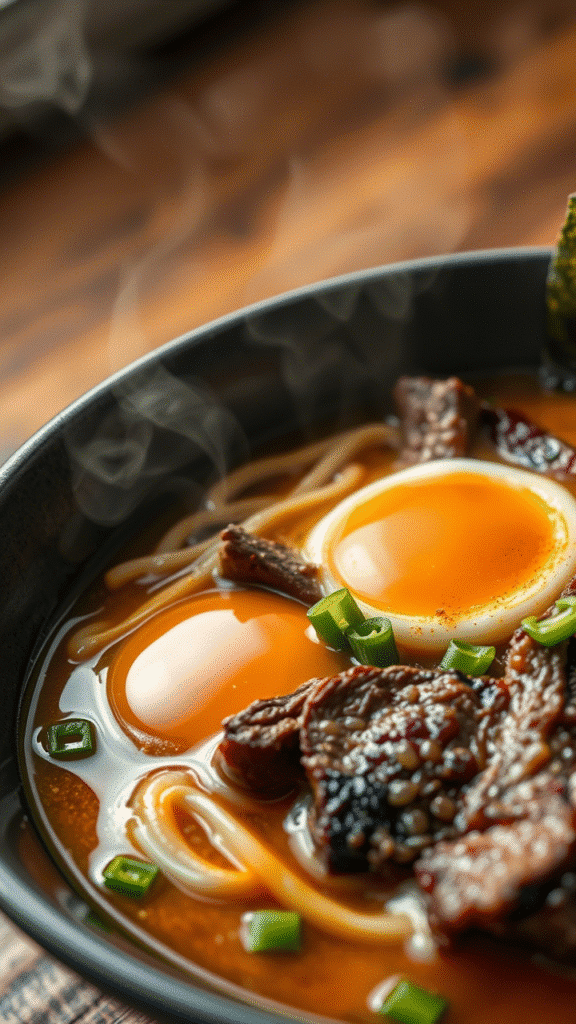
Collagen Conversion and Texture Development
The extended cooking time allows tough collagen fibers in chuck roast to slowly convert to gelatin. This process requires temperatures around 160-180°F maintained over several hours exactly what slow cookers excel at providing. The result is meat that shreds effortlessly while contributing body to the broth.
Unlike pressure cooking, which achieves similar results quickly, slow cooking allows flavors to develop gradually and marry completely. The gentle heat prevents proteins from seizing up, maintaining the beef’s moisture while breaking down connective tissues.
Flavor Layering and Maillard Reactions
The initial searing step creates complex flavor compounds through Maillard reactions the same process that browns bread or creates the crust on a perfect steak. These compounds add depth and richness that cannot be achieved through slow cooking alone.
Aromatic vegetables release their essential oils slowly during the extended cooking process. Onions develop sweetness as their natural sugars caramelize gently in the moist environment. Ginger and garlic mellow and become aromatic rather than sharp or pungent.
Umami Development and Concentration
Miso paste contributes not just saltiness but complex umami compounds created through fermentation. These amino acids and nucleotides interact with the beef’s natural glutamates, creating synergistic flavor enhancement that makes everything taste more “meaty” and satisfying.
The slow evaporation process concentrates flavors gradually, unlike rapid reduction methods that can create harsh or overly intense results. This gentle concentration maintains balance while building intensity.
Professional Presentation and Serving
Plating Like a Pro
Warm your serving bowls this isn’t just restaurant pretension, it’s practical. Hot broth in a cold bowl quickly loses temperature, and lukewarm ramen is disappointing ramen. Run bowls under hot water or place them in a low oven for a few minutes.
Place cooked noodles in each bowl first, creating a nest in the center. This prevents them from floating and makes the presentation more controlled. Ladle broth around and over the noodles, ensuring each bowl gets generous amounts of shredded beef and vegetables.
Garnish thoughtfully. A soft-boiled egg with a jammy yolk adds richness and visual appeal. Sliced green onions provide color contrast and fresh bite. A sprinkle of sesame seeds or a drizzle of chili oil adds textural interest and customizable heat.
Temperature and Timing Considerations
Serve immediately after assembly ramen waits for no one. The noodles continue absorbing broth even after plating, so timing is crucial. Have all garnishes prepared and ready before you start ladling.
Consider the eating experience. Provide proper ramen spoons and chopsticks if possible. The wide spoons help capture both broth and ingredients, while chopsticks allow for proper noodle handling. These details matter more than you might think.
Pairing and Accompaniments
Simple sides work best the ramen should be the star. Crispy vegetable gyoza make an excellent starter, their fried exterior contrasting beautifully with the soup’s richness. Pickled vegetables provide palate-cleansing acidity between bites.
For beverages, consider Japanese beer like Asahi or Sapporo, whose clean flavors won’t compete with the complex broth. Green tea offers a traditional, cleansing finish. Avoid heavy wines or spirits that might overwhelm the delicate flavor balance you’ve worked so hard to achieve.
Mastering Variations and Troubleshooting
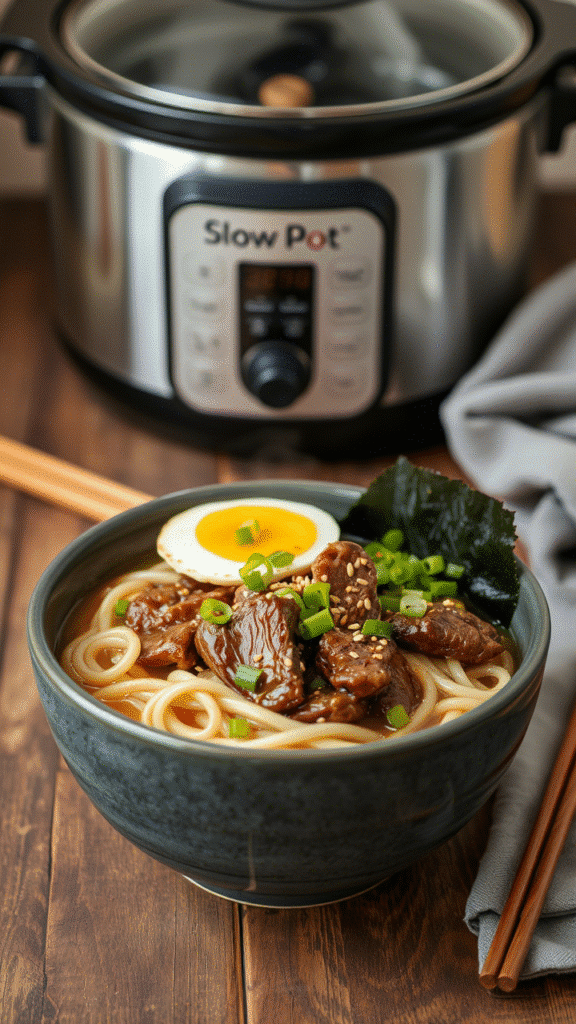
Flavor Customizations
Create a spicier version by adding Korean gochugaru or Japanese togarashi during the last hour of cooking. These chilies provide heat without overwhelming the beef’s richness. Start with 1 teaspoon and adjust according to your tolerance.
For deeper umami complexity, try adding a piece of kombu seaweed during cooking. Remove it before serving its job is to contribute glutamates, not texture. Dried shiitake mushrooms soaked and added with their soaking liquid provide another umami boost.
A tablespoon of tahini stirred in during the final 30 minutes creates a rich, nutty variation that’s particularly satisfying during cold weather. This technique borrows from tantanmen ramen traditions and works beautifully with beef.
Common Pitfalls and Solutions
Cloudy broth usually results from cooking at too high a temperature or adding noodles directly to the slow cooker. Maintain low heat settings and always cook noodles separately. If your broth is already cloudy, strain it through fine-mesh strainer lined with cheesecloth.
Overly salty results often happen when using different brands of soy sauce or miso than specified. These products vary significantly in sodium content. Always taste and adjust gradually, remembering that you can add salt but removing it is nearly impossible.
Mushy vegetables indicate they were added too early in the cooking process. Root vegetables like carrots can handle longer cooking, but leafy greens and delicate items should go in during the final 30 minutes maximum.
Storage and Reheating Excellence
Store components separately for best results. The broth and beef keep well together in the refrigerator for up to five days, actually improving in flavor as they meld. Vegetables are best added fresh during reheating to maintain their texture and color.
Freeze the broth and beef mixture in portions for up to three months. Thaw overnight in the refrigerator before reheating gently on the stovetop. Don’t microwave if possible it heats unevenly and can create hot spots that break down the beef’s texture.
When reheating, add a splash of fresh broth or water to compensate for evaporation during storage. Taste and readjust seasonings, as flavors can become muted during freezing.
The Professional’s Final Word
Slow cooker beef ramen represents everything beautiful about patient cooking transforming simple, inexpensive ingredients into something extraordinary through time and technique. The key lies not in exotic ingredients or complicated methods, but in understanding how flavors develop and interact over extended cooking periods.
This recipe rewards attention to detail while remaining forgiving enough for home cooks to achieve professional results. The searing step cannot be skipped, the timing of vegetable additions matters, and the final seasoning adjustments are crucial. Master these elements, and you’ll create bowls that rival any restaurant.
Remember that great ramen is about balance richness tempered by acidity, salt balanced by sweetness, and hearty comfort lightened by fresh garnishes. Each bowl should tell a complete story, from the first aromatic steam to the last satisfying slurp.
The beauty of this slow cooker method lies in its accessibility. You don’t need specialized equipment or years of training to create something genuinely special. You just need patience, quality ingredients, and respect for the process. The slow cooker does the heavy lifting while you go about your day, returning home to aromas that rival any professional kitchen.
Frequently Asked Questions?
Can I use a different cut of beef besides chuck roast?
Absolutely, though results will vary. Short ribs provide incredible flavor but cost more, while brisket offers similar texture with slightly different taste. Avoid lean cuts like sirloin or eye of round they’ll become dry and stringy. The key is choosing cuts with adequate marbling and connective tissue that benefit from long, slow cooking.
How can I make this recipe gluten-free?
Replace regular soy sauce with tamari and use certified gluten-free miso paste. For noodles, rice noodles or gluten-free ramen noodles work well, though cooking times may differ. Always check Worcestershire sauce labels, as some contain gluten many brands now offer gluten-free versions.
Can I prepare this recipe in advance for meal prep?
The broth and beef actually improve when made ahead flavors continue developing even after cooking stops. Store the broth mixture separately from noodles and fresh garnishes. Cook noodles fresh when serving, as they become mushy when stored in liquid. The broth keeps refrigerated for 5 days or frozen for 3 months.
What’s the best way to achieve restaurant-quality depth of flavor?
The searing step is non-negotiable it creates complex flavor compounds impossible to achieve otherwise. Use quality ingredients, especially soy sauce and miso paste. Don’t skip the aromatics sauté, and resist lifting the slow cooker lid during cooking. Finally, taste and adjust seasoning at the end this final balancing act separates good from great.
My broth turned out too salty how can I fix it?
Add unsalted beef broth or water to dilute the saltiness, then rebalance other flavors as needed. A small amount of sugar or mirin can help counter excess salt. For future batches, remember that different brands of soy sauce and miso vary significantly in sodium content start with less and adjust upward.
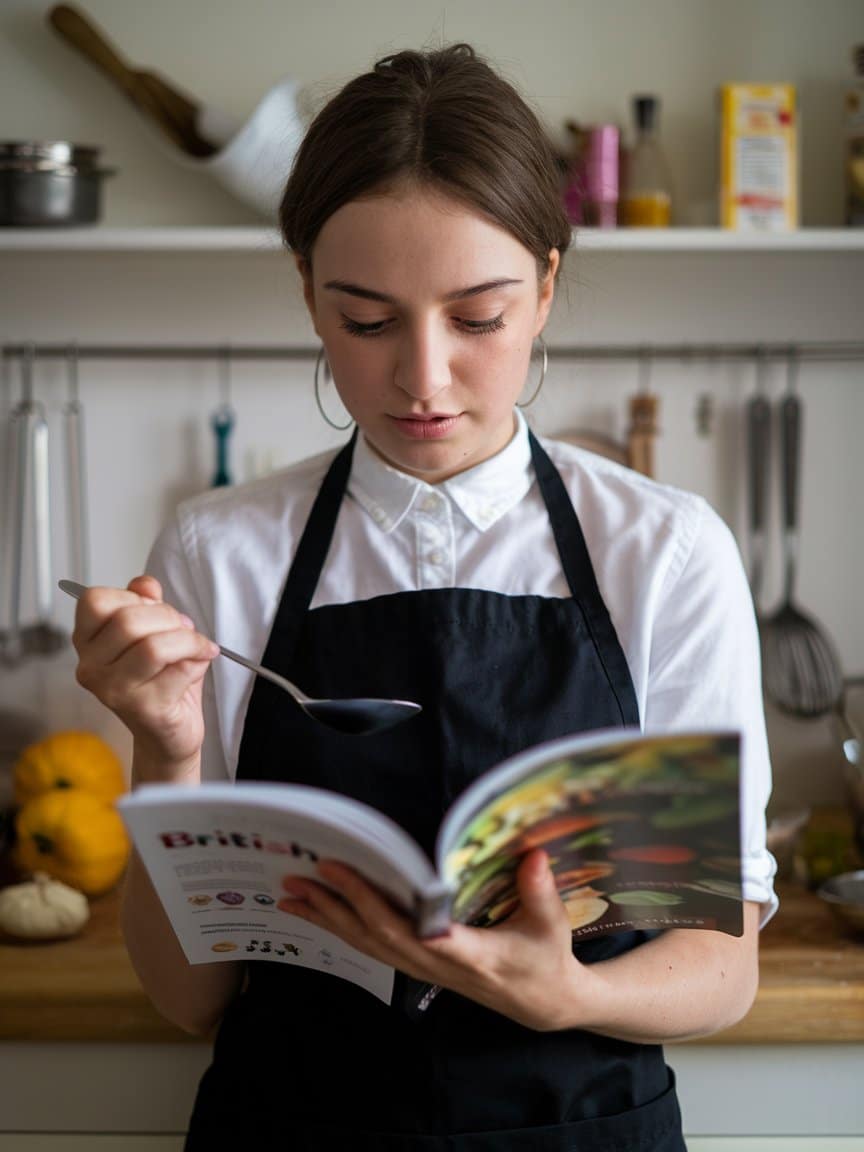
Veronica is a passionate food enthusiast with over three years of experience in exploring and writing about diverse cuisines. Her expertise lies in reviewing restaurants, sharing creative recipes, and discovering the latest food trends. As the voice behind FoodieRecap.com, Anju brings fresh perspectives and culinary insights to her audience.
